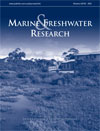Marine and Freshwater Research
Volume 63
Number 10 2012
The wetlands that occur along the coast of south-eastern Australia provide extremely valuable ecosystem services, such as providing habitat for animals and protecting the shoreline from erosion. Despite their importance, coastal wetlands are undervalued by the general community, by natural-resource managers, and by funding agencies. Increased attention – and funding – is required so that the likely effects of climate change can be assessed and degraded wetlands rehabilitated effectively.
Natural gradients in ocean temperature may be useful for predicting the likely responses of marine species to global warming. Seasonal and latitudinal variations in early life-history traits of a coral reef fish were examined, and significant correlations of pelagic larval durations and growth rates with temperature were identified. The findings emphasise the potential sensitivity of reef fish larvae to global warming.
Environmental Water Allocations (EWAs) are increasingly used to enhance native biota in regulated rivers but may also benefit alien invasive species like common carp (Cyprinus carpio). We examined the offstream movements of fish and turtles during a wetland EWA to gain insight into possible ways to limit carp invasion. Distinct movement patterns suggest that altering the timing of EWAs could potentially reduce carp invasion and provide some advantage to native fish but the benefits may be short-lived without additional measures such as wetland drying
Stable isotope biokinetics and discrimination factors can provide valuable information about food webs in threatened or important ecosystems. This study determined the biokinetics of 15N in the Australian freshwater crustacean, Cherax destructor, and showed its diet–tissue discrimination factors to be different to the typically assumed values for both 13C and 15N. This information about a keystone species will be valuable for future food-web studies.
The effects of aquaculture activity on benthic metabolism, C cycling and N transformations were studied in the tropical Nha Phu Estuary, Vietnam. The fish-farming activities lead to local increase of total benthic metabolism but low mineralisation rate of particulate organic matter loss in the form of faeces and feed due to the hydrodynamic features of the estuary. Our research highlights the critical assessment of aquaculture activity in tropical estuaries for sustainable development.
The majority of reef fish have a larval phase in the open ocean, where at the end of this they have to find and choose suitable habitat in which to settle as adults. Here we propose that settling snapper use chemical cues in which to choose their settlement habitat. Chemical signatures from seagrass habitats appear to be the most attractive to settling snapper.
The conservation of skates requires having knowledge on feeding habits and food partitioning among them. We analysed the inter-specific relationship of the diet between two closely related, morphologically similar and small skates and our results showed that these species have clearly different trophic traits. Knowing how sympatric species partition their resources is very important for understanding the mechanisms that influence marine community structure.
Seabirds already affected by human activity are now subject to global warming. The breeding performance of little penguins off Western Australia was clearly linked to local oceanographic factors over 20 years. For example, poor breeding success was correlated with high sea surface temperatures during pre-breeding. Little penguins are top predators, totally reliant on marine resources yet are readily accessible while breeding, making them useful indicators of changing marine conditions.
Coastal engineering aimed at reclaiming land and protecting coastal property from inundation is increasingly modifying estuarine habitats. Our study documented changes in the structure of mangrove forests adjacent to stretches of shoreline armored by seawalls. Where these changes cascade to the food webs supported by mangroves, impacts to fisheries productivity may result.
To date, quantitative studies interested in species or stock discrimination have focussed on the largest otolith, the sagitta. We asked whether the two smaller otoliths, the asterisci and lapilli, also provide species-specific characters. Future otolith studies may yield better results for species or stock discrimination if all three otoliths are used, due to additional shape information provided by the asterisci and lapilli.




